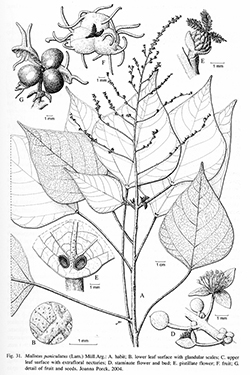e-Flora of Thailand
Volume 8 > Part 2 > Year 2007 > Page 416 > Euphorbiaceae > Mallotus
26. Mallotus paniculatus (Lam.) Müll.Arg.wfo-0000234677
Linnaea 34: 189 (1865); Airy Shaw, Kew Bull. 26: 298. 1972; Whitmore, Tree Fl. Malaya 2: 114. 1973; Airy Shaw, Kew Bull. Add. Ser. 4. 166. 1975; Welzen, Slik & Bollendorff in Welzen et al., Thai Forest Bull., Bot. 28: 103. 2000; S.E.C.Sierra & Welzen, Blumea 50: 261, 263, fig. 4, map 4. 2005.— Croton paniculatus Lam., Encycl. 2: 207. 1786.— Rottlera paniculata (Lam.) Blume, Bijdr. 11: 604. 1826. Fig. 31.
Accepted Name : This is currently accepted.
Synonyms & Citations :
Description : Shrub to tree, about 20 m high. Indumentum of densely stellately, patently hairy, glandular scales orangish. Stipules triangular, 0.5–1.2 by 0.3–0.8 mm. Leaves alternate (some opposite); petiole 2.2–16 cm long; blade ovate, 3.6–19.5 by 2.5–17 cm, length/width ratio 1.3–1.8, drying brownish, base usually slightly peltate, up to 1.5 mm, narrowly emarginate to round to usually cuneate, margin entire, seldom dentate, often with 2 lobes at widest part of blade, up to 3.5 cm long, apex cuspidate to caudate, upper surface with basally 2 large extrafloral nectaries near insertion, (1–)3 by (1–)2 mm, lower surface whitish because of hairs, (sparsely) with glandular scales, venation triplinerved. Inflorescences terminal, single, often branching. Staminate inflorescences up to 57 cm long, side branches up to 40 cm long, less than 1 mm thick; flowers in groups of up to 10 per node; bracts triangular, 0.4–0.8 by 0.6–1 mm. Staminate flowers 4–5 mm in diam., fragrant; pedicel 1.3–3.2 mm long; sepals 3–5, ovate to elliptic, 2–2.8 by 0.8–1.8 mm, pale light yellow; stamens ca 50; filaments 1.2–2.7 mm long, whitish; anthers ca 0.4 mm long, light yellow. Pistillate inflorescences becoming pendent, up to 38 cm long, side branches up to 14 cm long; bracts triangular, 0.5–0.6 by 0.4–0.6 mm; bracteoles indistinct. Pistillate flowers 2–4 mm in diam., yellow; pedicel 1.5–2(–2.5 mm in fruit) long; calyx with 4 or 5 lobes, 2–3 mm high, lobes ovate, 1.4–2.4 by 0.8–1 mm; ovary (2)3-locular, 1–1.8 by 1–2.5 mm, covered with ca 30 coarse spines up to 0.8 mm long; style 0.3–0.8 mm long; stigmas 2.2–2.5 mm long. Fruits lobed capsules, 5.5–6 by 4.2–4.5 mm, greenish-brown to greyish-tan, densely hairy, covered with 10–20 course spines up to 4 mm long; column 2.8–3.5 mm long. Seeds subglobose, 2.8–3.5 by 2.8–3.5 by 2.4–3 mm, glossy black.
Thailand : NORTHERN: Chiang Mai, Chiang Rai, Lampang, Phrae, Tak, Sukhothai, Phitsanulok; NORTH-EASTERN: Phetchabun, Loei, Nong Khai, Sakon Nakhon, Khon Kaen; EASTERN: Chaiyaphum, Nakhon Ratchasima; SOUTH-WESTERN: Kanchanaburi, Phetchaburi, Prachuap Khiri Khan; CENTRAL: Saraburi, Nakhon Nayok; SOUTH-EASTERN: Sa Kaeo, Chon Buri, Rayong, Chanthaburi, Trat; PENINSULAR: Ranong, Surat Thani, Phangnga, Krabi, Nakhon Si Thammarat, Trang, Pattani, Narathiwat.
Distribution : Burma, S China, Taiwan, Indochina, throughout Malesia (Java – type) to Australia (Queensland).
Ecology : Common pioneer in very secondary habitats like grassy clearings in montane mixed oak forests, dipterocarp forests, mixed deciduous forests; also along peat swamp margins, and along road sides and forests edges; soil: sandstone and granite bedrock; 0–1,500 m alt.
Vernacular : Sati ton (สตีต้น)(Loei); salat pang (สลัดป้าง), soi dao (สอยดาว)(Chanthaburi, Trat); lo khon (หลอขน)(Trang); saet (แสด)(Peninsular).
CommonName : Turn-in-the-wind.
Notes: See note under Mallotus tetracoccus.

